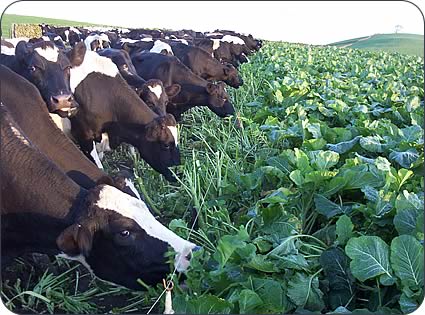Jennifer MacKenzie is an agricultural photo journalist with almost 30 year's experience. Operating from her base in Cumbria, Jennifer undertakes mainly industry-related freelance writing and photography.
Outwintering cattle on brassicas
The options for outwintering cattle on brassicas such as kale came into focus at a high profile forage conference in the north west of England this month.
 |
| Dairy cows feeding on this year's kale crop |
British Seed Houses’ inaugural event Forage 365 in Crewe on Thursday (December 1) addressed specific aspects of grazed grass, clover, forage maize and brassicas, covering topics that are relevant to both dairy and beef producers.
Cutting fixed costs should be a key focus for beef producers now farming without subsidies, according to Basil Lowman, of SAC.
Mr Lowman, one of eight speakers at the conference, examined cost cutting through year-round forage systems. He maintains that the biggest cost of UK beef production is money tied up in machinery and buildings.
Post de-coupling he believes that beef producers now have a blank sheet of paper on which to write a new business plan – and a move to year-round outdoor rearing systems where animals can self-feed on grass and fodder crops is one of the ways forward.
As well as major cost savings of around 50 per cent, outwintering cattle improved animal welfare and health – pneumonia, the biggest killer was mainly caused by housing - and trials showed that it did not compromise daily liveweight gain.
“All the language of agricultural economists has been on gross margins and fixed costs have been swept under the carpet,” Mr Lowman told the conference attended by 100 delegates.
“We have spent our lives reducing variable costs however by increasing our stocking rates to get more subsidies we have also increased our fixed costs.”
Mr Lowman described options for outwintering cattle on forage crops such as kale and swedes.
Kale, sown in May-June and swedes, sown April-June, both into sprayed off grass swards, could be strip grazed from November to March with a straw run back.
Stubble turnips could be sown into winter cereals, such as those grown for crimping or cracked wholecrop, three weeks pre-harvest. The straw could be baled and left in the field and the stubble turnips strip grazed from November to January.
New outwintered self feed systems could be used for store and finishing cattle. For grass finishing of spring born suckled calves it would cut out labour-intensive creep feeding with weaning in late January.
Cows and calves would be strip grazed on a leader-follower system. The system would minimise housing and turn-out checks and finished cattle could be sold from June onwards.
In a global market place, UK milk producers will have to compete with dairy farmers who are able to produce milk for the equivalent of 5p per litre.
This was the message to farmers attending the conference from Dr Padraig French, head of dairy research at the Moorepark Livestock Research Centre in Ireland.
Dr French gave the case of a New Zealand dairy farmer who was able to out winter 60 per cent of his cows on brassicas, leaving silage bales in the field in situ in the summer after baling for winter rations and keeping his costs down to the equivalent of 5p per litre.
“If we move towards globalisation you are going to have to compete with that producer,” he said.
Dr French said that while grass was the cheapest feed available in the UK and the saviour of the livestock industry going forward, variations in its supply and demand through the seasons led to increased costs in labour, oil and machinery to harvest it.
The costs of a three-month period of winter housing amounted to £199 a cow, broken down into silage at £67 a head, building depreciation at £86,slurry spreading £15 and feeding out and bedding at £31.
Outside winter feeding – on forage brassicas such as kale, swedes, turnips, or forage rape - amounted to only a third to half the cost of feeding cattle inside on grass silage/wholecrop diets.
Brassicas had the potential for providing cheap, high quality feed while making a big reduction in fixed costs.
Grazing Swedes gave the option of high yield potential of 10-15,000kg of DM/ha with a high feed value from a full-year crop, sown from May to mid July.
Forage kale also had a high yield potential when grazed as well as a high feed value. Forage rape, sown from mid July to mid September as a catch crop, had moderate yield potential but with a high feed value, but, importantly, had the ability to reduce nitrate loss.
* High profile speakers included Professor Mike Theodorou from IGER who explained the animal production benefits derived from increased nitrogen use efficiency in new generation ryegrass varieties; the Milk Development Council’s Hugh Black, provided a practical insight into extended grazing, with a focus on the latest research into cow track design; Dr Ernst Loop of Saaten Union, used his first-hand knowledge of northern European maize growing to examine the advantages of the very latest ultra early maturing varieties; Promar’s David Burns looked at the rationing implications of maize maturity; both white and red clover was addressed by IGER’s Dr Michael Abberton, with a focus on breeding developments and the potential to reduce nitrogen inputs through more effective use of modern varieties; Promar’s Derek Gardner looked at the economic advantages of clover, set in the context of a post CAP Reform agriculture.

